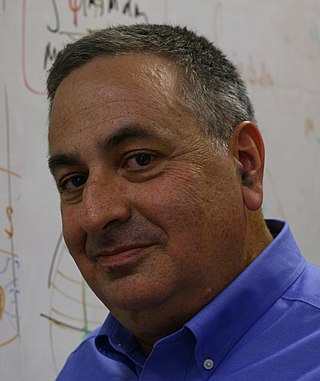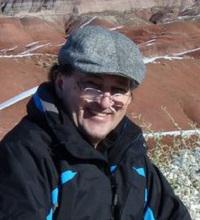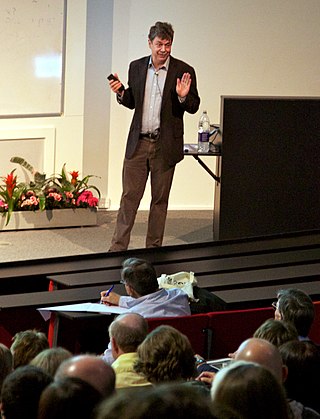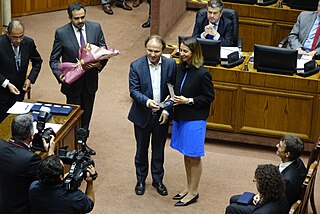Related Research Articles

The study of galaxy formation and evolution is concerned with the processes that formed a heterogeneous universe from a homogeneous beginning, the formation of the first galaxies, the way galaxies change over time, and the processes that have generated the variety of structures observed in nearby galaxies. Galaxy formation is hypothesized to occur from structure formation theories, as a result of tiny quantum fluctuations in the aftermath of the Big Bang. The simplest model in general agreement with observed phenomena is the Lambda-CDM model—that is, clustering and merging allows galaxies to accumulate mass, determining both their shape and structure. Hydrodynamics simulation, which simulates both baryons and dark matter, is widely used to study galaxy formation and evolution.
Jeremiah Paul "Jerry" Ostriker is an American astrophysicist and a professor of astronomy at Columbia University and is the Charles A. Young Professor Emeritus at Princeton, where he also continues as a senior research scholar. Ostriker has also served as a university administrator as Provost of Princeton University.

Margaret J. Geller is an American astrophysicist at the Center for Astrophysics | Harvard & Smithsonian. Her work has included pioneering maps of the nearby universe, studies of the relationship between galaxies and their environment, and the development and application of methods for measuring the distribution of matter in the universe.

Carlos Silvestre Frenk is a Mexican-British cosmologist. Frenk graduated from the National Autonomous University of Mexico and the University of Cambridge and spent his early research career in the United States, before settling permanently in the United Kingdom. He joined the Durham University Department of Physics in 1986 and since 2001 has served as the Ogden Professor of Fundamental Physics at Durham University.

Avishai Dekel is a professor of physics at the Hebrew University of Jerusalem, Israel, holding the Andre Aisenstadt Chair of Theoretical Physics. His primary research interests are in astrophysics and cosmology.

Fulvio Melia is an Italian-American astrophysicist, cosmologist and author. He is professor of physics, astronomy and the applied math program at the University of Arizona and was a scientific editor of The Astrophysical Journal and an associate editor of The Astrophysical Journal Letters. A former Presidential Young Investigator and Sloan Research Fellow, he is the author of six English books and 230 refereed articles on theoretical astrophysics and cosmology.
Lauro Moscardini is an Italian astrophysicist and cosmologist. Moscardini has studied N-body cosmological simulations with non-Gaussian initial conditions. The research activity is mainly focussed in the field of theoretical and observational cosmology, in particular with the application of numerical techniques in astrophysics and the study of the formation of large cosmic structures. Moscardini's research is a mixture of observations and building models of large scale structures in the universe.

Simon David Manton White, FRS, is a British-German astrophysicist. He was one of directors at the Max Planck Institute for Astrophysics before his retirement in late 2019.

Remo Ruffini is an Italian astrophysicist. He is the Director of ICRANet, International Centre for Relativistic Astrophysics Network and one of the founders of the International Centre for Relativistic Astrophysics (ICRA). Ruffini initiated the International Relativistic Astrophysics PhD, a common graduate school program of several universities and research institutes for the education of theoretical astrophysicists. He is the Director of the Erasmus Mundus IRAP PhD program. He has been Professor of Theoretical Physics at the University of Rome "Sapienza" from 1978 to 2012.

Priyamvada (Priya) Natarajan is a theoretical astrophysicist and professor in the departments of astronomy and physics at Yale University. She is noted for her work in mapping dark matter and dark energy, particularly in gravitational lensing and in models describing the assembly and accretion histories of supermassive black holes. She authored the book Mapping the Heavens: The Radical Scientific Ideas That Reveal the Cosmos.

Wendy Laurel Freedman is a Canadian-American astronomer, best known for her measurement of the Hubble constant, and as director of the Carnegie Observatories in Pasadena, California, and Las Campanas, Chile. She is now the John & Marion Sullivan University Professor of Astronomy and Astrophysics at the University of Chicago. Her principal research interests are in observational cosmology, focusing on measuring both the current and past expansion rates of the universe, and on characterizing the nature of dark energy.
Ma Chung-Pei is an astrophysicist and cosmologist. She is the Judy Chandler Webb Professor of Astronomy and Physics at the University of California, Berkeley. She led the teams that discovered several of largest known black holes from 2011 to 2016.
Jenny Greene is an Astrophysicist and Professor of Astrophysical Sciences at Princeton University. She is notable for her work on supermassive black holes and the galaxies in which they reside. Her work also involves a partnership with the Princeton Gravity Initiative and as co-founder and academic advisor to the Prison Teaching Initiative (PTI) at Princeton University.

Katherine J. Mack is a theoretical cosmologist who holds the Hawking Chair in Cosmology and Science Communication at the Perimeter Institute. Her academic research investigates dark matter, vacuum decay, and the Epoch of Reionization. Mack is also a popular science communicator who participates in social media and regularly writes for Scientific American, Slate, Sky & Telescope, Time, and Cosmos.
Juna Kollmeier is an astrophysicist from the US. She is currently employed at the Carnegie Institution for Science and is the director of the fifth phase of the Sloan Digital Sky Survey, which made its first observations in October, 2020. She served as the director of the Canadian Institute for Theoretical Astrophysics, located at the University of Toronto, from 2021 to 2024.

Burçin Mutlu-Pakdil is a Turkish-American astrophysicist, and Assistant Professor at Dartmouth College. She formerly served as a National Science Foundation (NSF) and Kavli Institute for Cosmological Physics (KICP) Postdoctoral Fellow at the University of Chicago. Her research led to a discovery of an extremely rare galaxy with a unique double-ringed elliptical structure, which is now commonly referred to as Burcin's Galaxy. She was also a 2018 TED Fellow, and a 2020 TED Senior Fellow.

Violette Impellizzeri is an Italian astronomer and astrophysicist specializing in active galactic nuclei and the molecular clouds surrounding supermassive black holes. She is currently a professor at Leiden University, where she conducts research on these phenomena using radio interferometry.

Shirley Ho is an American astrophysicist and machine learning researcher, currently at the Center for Computational Astrophysics at the Flatiron Institute, and an affiliated faculty at the Center for Data Science at New York University.
Barbara Sue Ryden is an American astrophysicist who is a Professor of Astronomy at Ohio State University. Her research considers the formation, shape and structure of galaxies. She was elected a fellow of the American Association for the Advancement of Science in 2016.

Marc S. Seigar is an astrophysicist, academic and author. He is the Dean of the College of Natural Sciences and Mathematics, and a Professor of Physics and Astronomy at the University of Toledo.
References
- ↑ "Tiziana Di Matteo", Physics faculty, Carnegie Mellon University, retrieved 2024-11-09
- ↑ Amos, Jonathan (April 7, 2005), "Deepest X-rays tell merger story", BBC News, retrieved 2024-11-09
- ↑ Cain, Fraser (February 10, 2005), "Black Holes Manage Galactic Growth", Universe Today, retrieved 2024-11-09
- 1 2 Roth, Mark (August 31, 2009), "The Thinkers: Black holes, black energy and the history of the universe", Pittsburgh Post-Gazette, retrieved 2024-11-09
- ↑ Wolchover, Natalie (June 12, 2018), "The universe is not a simulation, but we can now simulate it", Quanta Magazine, retrieved 2024-11-09
- ↑ "Worldly", CMU Today, April 2010, retrieved 2024-11-09
- 1 2 Curriculum vitae (PDF), Carnegie Mellon University, retrieved 2024-11-09
- ↑ "Tiziana M. Di Matteo", AstroGen, American Astronomical Society, retrieved 2024-11-09
- ↑ "Fellows nominated in 2014", APS Fellows archive, American Physical Society, archived from the original on 2023-01-07